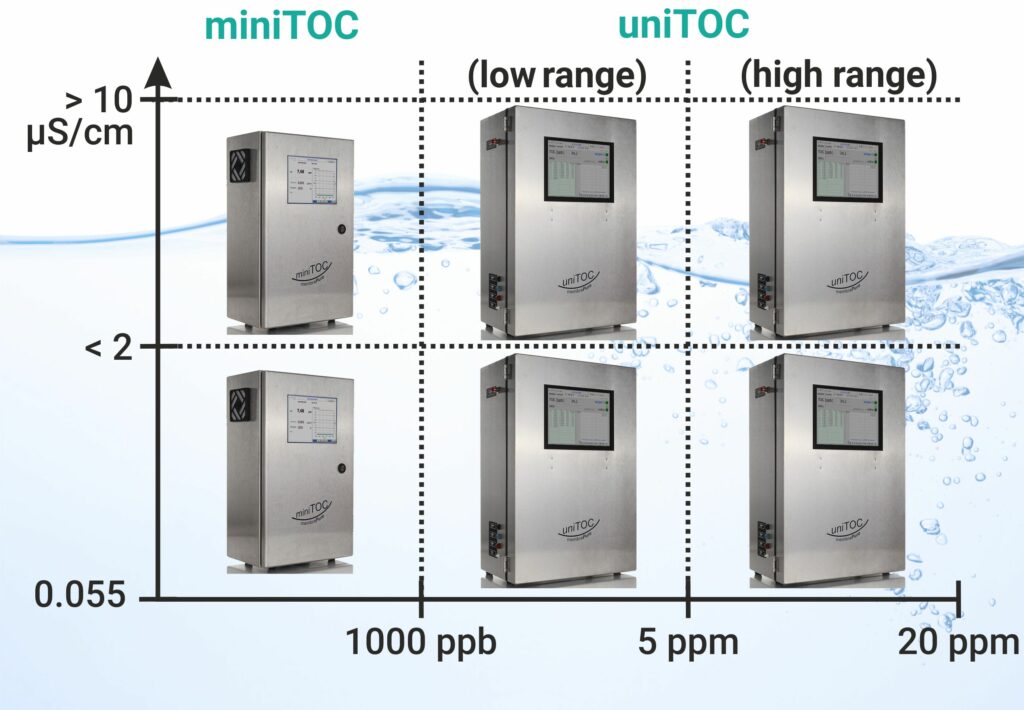Schreiben Sie uns!
Rufen Sie uns an!
Home > TOC
Our TOC Analyzers enable analysis of different water qualities – from ultra pure water in the pharmaceutical industry and in power plants up to waste water from Production site (up to 20 ppm) – we provide the right instrument for the determination of your TOC. Both systems use UV radiation as the oxidation method. For uniTOC the oxidation process can be enhanced with additionals dosage of reagent. The miniTOC uses conductivity measurement and the uniTOC uses NDIR detection for TOC determination.
Each of the detection methods have their respective advantages. The miniTOC is more convenient for pure and ultra pure water (conductivity < 2 µS/cm, optional also up to 30 µS/cm), whereas the uniTOC unit offers a wider application spectrum. Both systems have also an offline mode to measure grab samples. All systems can be qualified with IQ/OQ documents.

The abbreviation TOC stands for "Total Organic Carbon" and provides information about the presence and quantity of organic components in a medium.
This value indicates the total content of organic components, but does not allow any statement about the exact components.
Conductivity measurement is already used for quality monitoring. However, since most organic compounds are non-ionic in nature, they cannot be detected by conductivity measurement. This requires a different analysis such as TOC measurement. Since TOC measurement can also be carried out in online mode, it is very well suited as a monitoring method.
The TOC method, originally developed for the monitoring of drinking water and wastewater, is now also used in the pharmaceutical sector, in the semiconductor industry and in energy production. In the pharmaceutical industry, this measurement method is now regulated by USP 643 (United States Pharmacopoeia) and EP 2.2.44 (European Pharmacopoeia) and is mandatory for use.
TOC measurements should be taken before the sampling points and at specific points in the water treatment process.
- After reverse osmosis, to check the membrane efficiency.
- After deionization to check resin efficiency and to infer possible biological contamination of the resin material.
- After storage in a clean water tank for further use
- After the UV lamp used to reduce the TOC content in the product water. An increase in the TOC content indicates a decrease in the efficiency of the UV lamp or its damage
- After the deionization of the pure water
Online measurement systems usually make use of UV oxidation and differential conductivity measurement or NDIR detection to determine organic contaminants. In the case of differential conductivity measurement, the UV lamp oxidizes the organic components, converting them to carbon dioxide and water or, in an equilibrium step, to carbonic acid, which in turn has an effect on conductivity. The conductivity of the sample is measured before and after UV oxidation and calculated via prior calibration with a reference value.
We would like to improve the contact to our customers & partners and send you information and updates about our company and our products

membraPure endeavours as far as reasonably possible to provide correct and complete information on this website. However, membraPure does not guarantee that the information provided is up-to-date, correct and complete. The same applies to the content of external websites that this site refers to directly or indirectly via hyperlinks, programmes, files, contents or hyperlinks to other websites are provided without any expressed or implied warranty.
Contact Us
membraPure reserves the right to alter the information provided on this site without prior notice.
membraPure GmbH, Wolfgang-Kuentscher Str. 14, 16761 Hennigsdorf